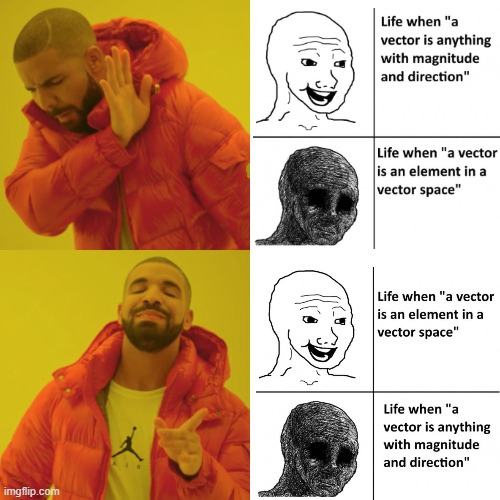this post was submitted on 08 Sep 2024
136 points (95.3% liked)
Science Memes
10340 readers
1130 users here now
Welcome to c/science_memes @ Mander.xyz!
A place for majestic STEMLORD peacocking, as well as memes about the realities of working in a lab.

Rules
- Don't throw mud. Behave like an intellectual and remember the human.
- Keep it rooted (on topic).
- No spam.
- Infographics welcome, get schooled.
Research Committee
Other Mander Communities
Science and Research
Biology and Life Sciences
- [email protected]
- [email protected]
- [email protected]
- [email protected]
- [email protected]
- [email protected]
- [email protected]
- [email protected]
- [email protected]
- [email protected]
- [email protected]
- [email protected]
- [email protected]
- [email protected]
- [email protected]
- [email protected]
- [email protected]
- [email protected]
- [email protected]
- [email protected]
- [email protected]
- [email protected]
- [email protected]
- [email protected]
- !reptiles and [email protected]
Physical Sciences
- [email protected]
- [email protected]
- [email protected]
- [email protected]
- [email protected]
- [email protected]
- [email protected]
- [email protected]
- [email protected]
Humanities and Social Sciences
Practical and Applied Sciences
- !exercise-and [email protected]
- [email protected]
- !self [email protected]
- [email protected]
- [email protected]
- [email protected]
Memes
Miscellaneous
founded 2 years ago
MODERATORS
you are viewing a single comment's thread
view the rest of the comments
view the rest of the comments

Start with a list of numbers, like [1 2 3]. That's it, a list of numbers. If you treat those numbers like they represent something though, and apply some rules to them, you can do math.
One way to consider them is as coordinates. If we had a 3-D coordinate grid, then [1 2 3] could be the point at x = 1, y = 2, and z = 3. You could also consider the list of numbers to be a line with an arrow at one end, starting from the point at [0 0 0] and stopping at the other point. This is a geometric vector: a thing with a direction and a magnitude. Still just a list of numbers though.
Now, what if you wanted to take that list and add another one, say [4 5 6], how might you do it? You could concatenate the lists, like [1 2 3 4 5 6] and that has meaning and utility in some cases. But most of the time, you'd like "adding vectors" to give you a result that maps to something geometric such as putting the lines with arrows end-to-end and seeing what new vector that is. You can do that by adding each element of the 2 vectors. And, almost magically, the point at [5 7 9] is where you'd end up if you first went to [1 2 3] and then traveled [4 5 6] further. We made no drawings, but the math modeled the situation well enough to give us an answer anyway.
Going further, maybe you want to multiply vectors, raise them to exponents, and more? There are several ways to do these, and each has different meanings when you think about them with shapes and geometry.
But vectors are just lists of numbers, they don't have to be geometric things. [1 2 3] could also represent the coefficients of a function, say 0 = 1x^2 + 2x + 3(x^0). You can still do the same math to the vector, but now it means something else. It models a function, and combining it with other vectors let's you combine and transform functions just like if they were lines and shapes.
When you get into vectors beyond 3 elements, there's no longer a clean geometric metaphor to help you visualize. A vector with 100 elements can be used just as well as one with 2, but we can't visualize a space with 100-dimensions. These are "vector spaces" and a vector is a single point (or rather, points to a point) within them.
Matrices are similar but allow for deeper models of more complex objects.
Very well explained, thank you. I keep forgetting, and am occasionally reminded, that just below the basic math I'm familiar with is a whole other level of advanced math, and just below that is the screaming void.